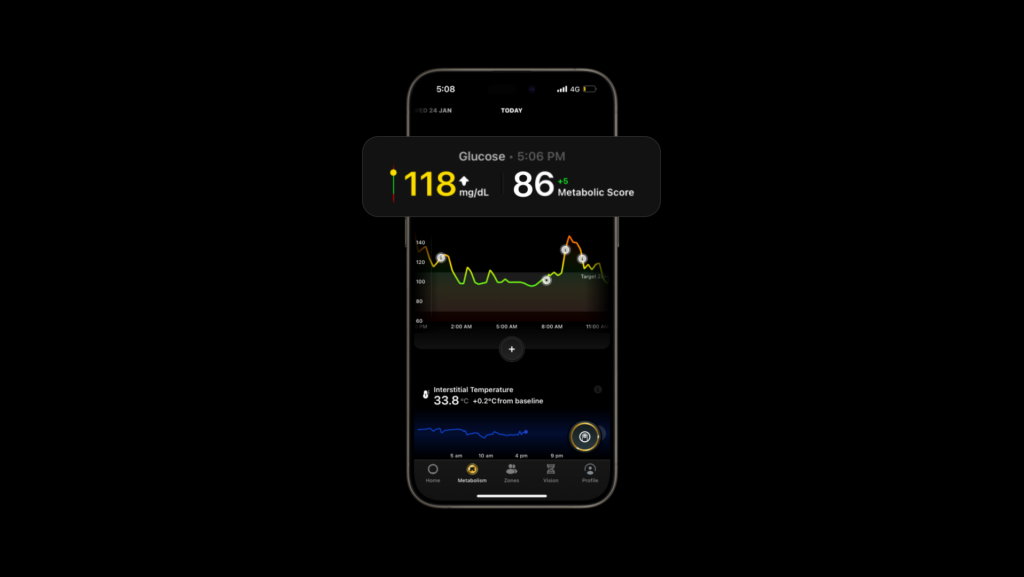Rapid blood glucose swings between meals could quietly be stressing your body at the cellular level, and trigger a state called oxidative stress.
Oxidative stress is a state of metabolic imbalance that drives inflammation, impairs recovery, and accelerates aging.
Studies show that glucose spikes over 140 mg/dL are common even in those with “normal” labs. If you’ve ever worn a continuous glucose monitor (CGM), you’ve likely seen sharp rises after meals and reactive dips a few hours later.
These swings might seem harmless, but they’re increasingly recognized as metabolic red flags. Oxidative stress is a problem that could cause long-term health issues.
Read next: What is metabolic age and how is it calculated
What is glucose variability?
Glucose variability refers to the swings in blood glucose levels throughout the day. It’s not about where your glucose sits on average, but how far and how frequently it rises and falls.
Common measures include standard deviation (SD), coefficient of variation (CV), and MAGE (mean amplitude of glycemic excursions). A CV under 12% is often considered a target for stable glucose patterns.
Unlike average glucose, which smooths over highs and lows, glucose variability reflects real-time metabolic stress. Large swings can impair insulin signaling, worsen hunger and fatigue, and disrupt vascular health..
How glucose swings generate oxidative stress

Every time glucose spikes sharply, it challenges the mitochondria in your cells to keep up with energy demands. When overwhelmed, these mitochondria produce excess reactive oxygen species (ROS)—unstable molecules that damage DNA, lipids, and proteins. This process is known as oxidative stress.
Oxidative stress activates inflammation, promotes the formation of advanced glycation end-products (AGEs), and disrupts endothelial function in blood vessels. These effects mirror those seen in chronic diseases like diabetes and cardiovascular disease, even in people without a diagnosis.
Read next: How are metabolic scores calculated?
Who’s most at risk?
The strongest evidence for harm from glucose variability comes from people with diabetes. For them, glucose excursions are often larger and more prolonged, creating an environment ripe for oxidative stress. In this population, GV is associated with endothelial dysfunction, cardiovascular risk, and worse outcomes overall.
But glucose variability also matters for people without diabetes. especially those with insulin resistance, sleep disruption, or high body fat. Studies show that many non-diabetic individuals experience post-meal spikes well over 140 mg/dL, which is above the threshold where oxidative stress pathways are triggered [PMID: 18503966].
And because these excursions often don’t show up on fasting glucose or A1c tests, CGM data can reveal early warning signs of metabolic friction that would otherwise go unnoticed.
How to reduce glucose variability and oxidative stress

The good news is that glucose variability can be controlled and reduced. Glucose swings respond directly to daily choices about what and how you eat, when you move, as well a sleep and stress levels.
Meal timing and composition play a major role. Prioritizing protein and fiber at the start of a meal, rather than jumping straight into starches, can blunt postprandial spikes. So can reducing ultra-processed carbs, especially refined grains and sugary beverages.
Movement is another powerful tool. A 10–30 minute walk after eating can significantly reduce post-meal glucose spikes in both diabetic and non-diabetic individuals. Regular resistance and aerobic training build glucose resilience by improving insulin sensitivity and muscle glucose uptake.
Sleep and stress also matter. Poor sleep increases cortisol, which promotes gluconeogenesis and insulin resistance. Chronic psychological stress, similarly, can spike glucose via the HPA axis. Managing both—through consistent sleep schedules, mindfulness, or targeted recovery protocols—can help keep your glucose curve flatter and cleaner.
Summary
Big glucose swings can quietly stress your body and speed up aging. They trigger oxidative stress, which damages cells and raises inflammation.
Good metabolic health practices, such as steady meals, walking after you eat, better sleep, and keeping stress in check, are the tools at your disposal to maintain better metabolic health.








